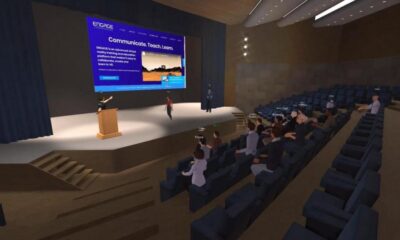NEWS
Lifelong Learning Requires An Evolving University

“I am still learning,” Michelangelo reportedly said at the age of 87. He continued to learn, evolve his craft and stay productive until the end of his life. As global life expectancy increases we should all continue to learn, stay productive and evolve our craft – including universities.
People are living longer
The World Health Organization shows global average life expectancy for those born in 2015 at 71.4 years – an increase from the cohort born in 2000, whose life expectancy at birth was 66.4. As you might imagine, life expectancy numbers range widely by country, from a high of 89.5 years in Monaco to a low of 50.2 in Chad, and everything in between. For example, Japan has an average life expectancy of 85, Iceland’s is 83, France’s is 81.8, the United Kingdom’s is 80.7, the United States’ is 79.8, Mexico’s is 75.9, Saudi Arabia’s is 75.3 and India’s is 68.5.
These are all average life expectancies, so roughly 50% of people are expected to live longer than the average, with some expected to live much longer. This has profound implications for individuals, employers, societies – and colleges and universities.
Twenty years ago, higher education thought of a ‘typical student’ as someone between the ages of 18 and 25. Now colleges and universities have expanded educational programming toward working professionals and those in search of ‘re-tooling’ for a new job or career and the student age range has increased apace. But have we expanded our view far enough?
More people stay productive well beyond age 60
An increasing number of people want to – and can – stay productive well beyond age 60. Beyond Michelangelo, there have been other very successful (and famous) people who started businesses and new careers well past their 20s and 30s and-or continued working late in life.
Some examples include Julia Child, who wrote her first cookbook at age 50 and became one of the world’s first celebrity chefs soon after; Tim and Nina Zagat, who started publishing restaurant reviews at age 51 and grew the Zagat company into a formidable culinary authority; Robin Chase, who started ZipCar at age 42; Anna Mary Robertson Moses (aka Grandma Moses), who began a prolific painting career at 78; and Ray Kroc, who bought McDonald’s at the age of 52 and grew it into the world’s largest fast-food franchise.
More people want to work well beyond what we consider retirement age and an increasing number of them are doing so. According to a Wall Street Journal article: “The 55-and-older crowd is now the only age group with a rising labour-force participation rate, even as age discrimination remains a problem for many older job seekers.
“Workers age 50 or older now comprise 33.4% of the US labour force, up from 25% in 2002. And more than 60% of workers age 65 or older now hold full-time positions, up from 44% in 1995.”
The article goes on to say that as economies shift “from manufacturing to services, it’s creating more positions in which cognitive skills matter more than physical ability. That means more opportunities for older workers … There may be deep neurological factors at play.
“Academics have found that knowledge and certain types of intelligence continue to develop in ways that can offset age-related declines in the brain’s ability to process new information and reason abstractly. Expertise deepens, which can enhance productivity and creativity. Some go so far as to say that wisdom – defined, in part, as the ability to resolve conflicts by seeing problems from multiple perspectives – flourishes.”
However, as industries change, the world of work evolves, and people expect to have multiple careers (not just jobs) over their lifetime, so individuals need to continually update their skills.
This represents an opportunity for colleges and universities to support the ageing workforce and the organisations employing them by expanding programming toward the needs of this more mature demographic.
There are already forays by institutions of higher education and other organisations into the lifelong learning space, including:
- Continuing Education Units: These have been around for more than 100 years at some institutions and are new to many others – these units are often the innovation engines (and new revenue generators) for colleges and universities and some have begun offering more programming geared toward the older age group.
- Coursera: There is some great content here from a variety of higher education institutions across the globe – everything from data analytics, computer science and business topics through to a host of liberal arts courses.
- Khan Academy: The organisation that started as a tutorial site for K-12 students now proudly proclaims that it is “a personalised learning resource for all ages” and offers a wide range of courses or topics.
- Bernard Osher Foundation and Osher Institutes: Osher provides funding and guidance for programming “targeted toward more mature students not necessarily well served by standard continuing education curricula”.
- The Plato Society: An organisation in California that promotes “curious minds learning from each other”.
- Road Scholar: This offers educational travel for older adults and partners with a variety of Lifelong Learning Institutes, many of which are affiliated with colleges and universities.
It can’t be business as usual
This is a good start – and we need to do more. Lynda Gratton noted in a recent MIT Sloan Management Review article: “It is clear that lifelong learning would meet the needs of the trends that are currently well underway. But this concept demands a focus and society-wide commitment that is not yet in place.
“We need to change that … anticipating jobs and providing access to lifelong learning demands a complex system involving multiple stakeholders: educators that extend the reach of their programmes from being front-ended on teenagers and 20-somethings to delivering educational options to students of all ages; governments that commit to helping citizens understand future job markets and the skills they will require and that realign tax and financial incentives; and corporations that create work environments that support education and enable employees to engage in extended periods of training.”
Universities can continue to learn and evolve too
Vijay Govindarajan, author of The Three-Box Solution: A strategy for leading innovation, notes that, to be successful in innovating for the future, organisations must expend effort in three distinct areas:
- Manage the Present: Keep the current business running.
- Create the Future: As Alan Kay, an American computer scientist, so wisely said, “the best way to predict the future is to invent it”. Study what is happening in demographics, technology, popular culture, labour markets and other areas to look for shifts that may disrupt your business and-or create opportunities to innovate for the future.
- Selectively Forget the Past: Forget (parts of) what made the current business successful, as many of these elements may not be needed for the next iteration – and many of them may, in fact, hinder the organisation from successfully innovating and creating the future. This is why innovation often needs a dedicated unit, led by someone outside the ‘traditional’ organisation and staffed by a mixture of people from inside and outside the traditional organisation – this allows new ways of thinking and behaving to flourish.
From years of working in and around higher education, I’d say that managing the present has become more difficult as higher education has become more expensive (and many governments have become less inclined to fund it), competition has increased and technology has become more important for everything, from marketing to content delivery, measuring learning outcomes and continuing to engage with alumni.
Many of the shifts for the higher education market have been well documented, including evolving employer needs for talent, unbundling the components of higher education delivered by colleges and universities, and how universities are evolving. And yet, most colleges and universities continue to operate much as they did 100 years ago.
Universities are full of very smart people, those who can see the future and understand the implications. Change is difficult and universities need to learn new ways of thinking, operating and executing – selectively forgetting some of the ways of doing things in the past (for example, tenure) in order to fully invent and realise the future of higher education. This is not easy.




















